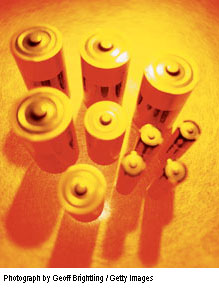|
|

by Chris Bryant
 Modern consumers expect to be able to talk on the phone, listen to music, and compose e-mails far from the tyranny of outlets and extension cords. Lighter, smaller, and more powerful batteries fuel this glut of portable gadgetry, from palm-size organizers to handheld video games, screwdrivers to toothbrushes. With the use of cordless items increasing 66 percent between 1999 and 2002, the average American household now has five such products. Modern consumers expect to be able to talk on the phone, listen to music, and compose e-mails far from the tyranny of outlets and extension cords. Lighter, smaller, and more powerful batteries fuel this glut of portable gadgetry, from palm-size organizers to handheld video games, screwdrivers to toothbrushes. With the use of cordless items increasing 66 percent between 1999 and 2002, the average American household now has five such products.
But this electronic freedom has its environmental price. Of the 3 billion "dry-cell" batteries Americans buy each year, only about 10 percent are rechargeable. Dry-cell batteries derive their power from the chemical reaction between different paste-like or powdery compounds; a metal or graphite core transmits the resulting charge. (The 99 million lead-acid car batteries manufactured every year use liquid acid and lead plates instead.) For example, a typical alkaline battery contains manganese dioxide and zinc, which react to form zinc oxide. In most cases, this chemical reaction only goes one way, so the battery runs out of juice after no more than 20 hours and gets tossed in the trash.
With so many batteries dumped after one go-round, plenty of energy and material get wasted. Manufacturing a typical "AA" single-use battery takes about 50 times as much energy as it provides, according to the UK’s environmental agency. And while most batteries no longer contain mercury, even rechargeable batteries still have toxic elements. (Small "button" batteries are a notable exception to the the 1996 Battery Act, which prohibited the use of mercury and led to mercury-zinc batteries being replaced by zinc-air or lithium varieties.) The EPA reports that batteries provided about 75 percent of the cadmium found in landfills in 1995, along with other heavy metals and acids. If these toxics leach out of the landfill or, more likely, escape from incinerator stacks, they can pollute aquatic environments and cause human symptoms ranging from headaches to an increased risk of cancer.
What Next?
REDUCE The average American tosses out about eight batteries a year, according to the EPA. That’s clearly a number that can be reduced, by recycling, recharging, or simply buying fewer battery-powered products. Limiting your consumption of superfluous gadgetry, much of which soon becomes obsolete anyway, is ultimately the most effective way to reduce waste.
RECHARGE Recharging a battery basically reverses the chemical reaction that provides the power. Rechargeable nickel metal hydride (NiMH) batteries are a smart alternative, both economically and environmentally: Properly used, a rechargeable NiMH AA battery will outlast hundreds of disposables, plus they’re easily recycled. A solar charger reduces the energy costs even further. One caution: Because their charge can drain while idle, rechargeable batteries are not a wise choice for smoke alarms. Follow the manufacturer’s directions to make sure you use the correct battery for the job.
RECONDITION Despite its clear advantages, even the best rechargeable battery’s chemical reaction is not reversible forever. Battery specialty stores, listed in many yellow pages under "batteries," can recondition old rechargeables for just a few dollars. This means that they can manipulate an older battery with a series of charges so it can be used longer, a process that takes up to 24 hours and is especially useful for batteries not recharged properly the first time around.
RECYCLE Few recycling programs exist for disposable batteries in the United States because of the high amounts of energy required by current recycling methods, the low value of recovered materials, and a lack of infrastructure for sorting and transporting them. Some hardware and drug stores collect disposable batteries in order to keep them out of municipal dumps, but they often end up being shipped long distances to a recycling plant. Although efforts to divert single-use batteries from the waste stream are growing, only a patchwork of regulations currently exists, depending on where you live. Recycling rechargeable batteries, however, is easy and free. The Rechargeable Battery Recycling Corporation will help you find a nearby drop-off point. Just visit www.rbrc.org or call (800) 8-BATTERY.
Chris Bryant is a freelance writer based in Missoula, Montana. |